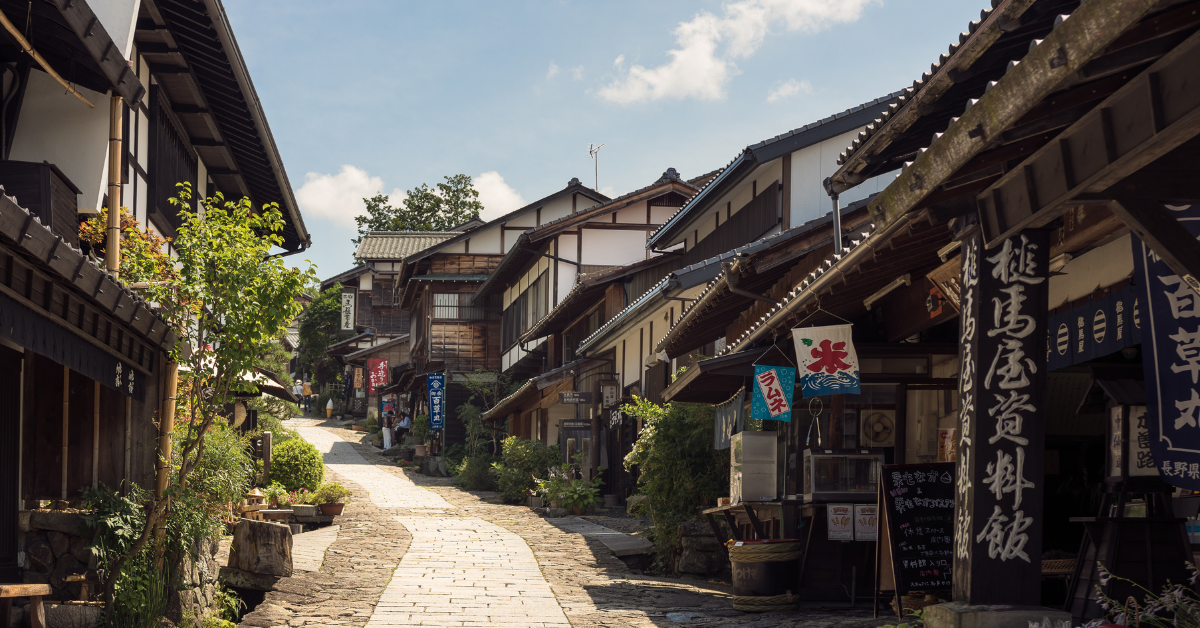Walking through Tsumago-juku and Magome-juku feels like stepping back into the Edo period. These towns are not only preserved historical sites but also living cultural landscapes cherished by Japanese people. Foreign travelers can discover how Japanese visitors appreciate these places and why they are considered national treasures.
What Are Tsumago-juku and Magome-juku?
The Nakasendo was one of the five major highways connecting Edo (Tokyo) and Kyoto. The post towns along its route were essential for travelers. Tsumago-juku and Magome-juku are especially famous because they still retain much of their Edo-period charm.
For Japanese people, these towns are not just names in history books. They are living pieces of history that can still be experienced firsthand. With their preserved architecture and atmosphere, many feel they are encountering the original landscape of Japan.
Why Japanese People Value Tsumago-juku
Tsumago-juku is widely known as the “preserved town”. From the 1970s, residents united to protect the townscape, attracting national attention. Thanks to these efforts, Tsumago-juku avoided being overtaken by commercial development and gained recognition as a cultural treasure.
| Points Japanese Value | Reasons |
|---|---|
| Historical preservation | Power lines and flashy signs removed, Edo-era scenery faithfully restored |
| Quiet atmosphere | Even with visitors, the town maintains a calm impression |
| Cultural experiences | Traditional foods and crafts provide hands-on cultural immersion |
| Pleasant scale | Small enough to explore comfortably on foot |
For Japanese visitors, Tsumago-juku is a place to find peace of mind and a sense of nostalgia.
Why Japanese People Value Magome-juku
Magome-juku is known as the “slope town”, built along a hillside that creates a unique, layered landscape. It is also the birthplace of the novelist Shimazaki Toson, who set his masterpiece Before the Dawn here, adding literary depth to its appeal.
| Points Japanese Value | Reasons |
|---|---|
| Slope-town charm | Rare among post towns for its dramatic elevation changes |
| Literary value | Birthplace of Toson and backdrop of his works |
| Seasonal beauty | Cherry blossoms in spring, vivid foliage in autumn |
| Lively main street | Tea houses and souvenir shops create a cheerful atmosphere |
For Japanese visitors, Magome-juku represents the balance of liveliness and nostalgia. While Tsumago-juku symbolizes tranquility, Magome-juku is seen as a town where history and tourism harmonize.
Comparing Tsumago-juku and Magome-juku
Japanese people often visit both towns, appreciating their contrasting qualities.
| Post Town | Japanese Impression |
|---|---|
| Tsumago-juku | A town prioritizing preservation of history. Popular with those seeking peace and quiet. |
| Magome-juku | A town for enjoying slopes, scenery, and literature. Favored by those wanting lively sightseeing. |
For Japanese visitors, the contrast between “stillness and liveliness” defines the charm of these two towns.
Recommended Experiences for Foreign Travelers
Foreign visitors can enjoy these towns even more by experiencing them as Japanese people do.
| Recommended Experience | Details |
|---|---|
| Tsumago-juku | Try local foods like gohei mochi (skewered rice cake) and soba noodles while strolling |
| Magome-juku | Visit the Toson Memorial Museum to learn about history and literature |
| Hiking | Walk the 8-km trail along the old Nakasendo between the two towns |
Walking between the two towns offers a chance to feel like an Edo-period traveler, which Japanese visitors greatly appreciate.
Seasonal Highlights
One of the greatest charms of Tsumago-juku and Magome-juku is their changing beauty through the four seasons.
| Season | Japanese Evaluation |
|---|---|
| Spring | Cherry blossoms create a festive and colorful atmosphere |
| Summer | Fresh greenery and cool breezes make walking pleasant |
| Autumn | Brilliant foliage makes this the most popular season |
| Winter | Covered in snow, the towns become quiet “silver post towns” |
Japanese visitors especially love autumn foliage, when the scenery is at its most spectacular.
Values That Japanese People Find Here
For Japanese people, Tsumago-juku and Magome-juku are more than tourist attractions. They are places where culture and nature come together.
| Value | Meaning for Japanese People |
|---|---|
| Preservation of history | Faithfully maintaining Edo-period scenery for future generations |
| Harmony with nature | Townscapes integrated with mountains and seasonal beauty |
| Peace of mind | A place to escape daily busyness and enjoy slow time |
| Learning opportunities | On-site experience of literature and history |
These qualities make the towns destinations that Japanese people feel are worth visiting again and again.
Conclusion
For Japanese people, Tsumago-juku and Magome-juku are places to feel the spirit and scenery of Edo Japan. Tsumago-juku symbolizes quiet preservation, while Magome-juku represents literature and liveliness. Visiting both allows travelers to understand Japanese views on history and nature.
For foreign travelers, these towns offer experiences beyond Tokyo and Kyoto. Walking the cobblestones, admiring the wooden houses, and tasting local food provide an authentic encounter with the Japanese sense of beauty.






